Experts Share Best Practices on Using Support Feedback to Improve Products

Table of contents
Have you ever wondered what drives product development? Or how some companies seem to always be a step ahead of their competitors?
The answer might be simpler than you think: certain companies continuously improve their products, by using customer feedback smartly.
But, here’s the challenge.
Feedback from customers is often collected by customer support and customer success teams in a company. These teams have the most important insights on what’s working, what frustrates customers, what could make the product better, and so on.
So, how can product or development teams tap into this feedback? How can they collaborate with support and customer success teams to develop product roadmaps that align with customer needs?
I reached out to important customer service leaders to understand this.
I asked them how they ensure that support feedback is integrated into product development.
Here’s what I found.
Voice of Customer (VoC) programs are the answer.
VoC programs are much more than just a means to collect feedback. They’re meant to go deeper, aiming to truly understand customers’ needs, desires, and any problems they might be facing with products or services.
For instance, Stephanie Ouellet, Senior Manager of Customer Experience at Earth Rated, has successfully implemented a Voice of the Customer (VoC) program – which led to major product enhancements as well as a new product launch – based on consumer feedback.
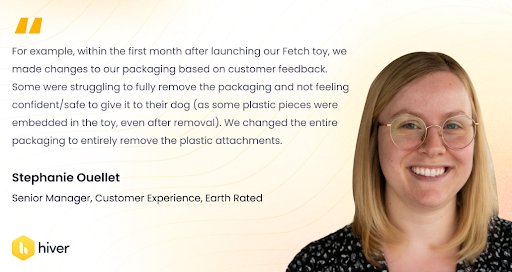
Similarly, Karen Lam, who is in charge of Customer Support at Top Hat, talks about the importance of listening to customers and training engineers to understand customer feelings.
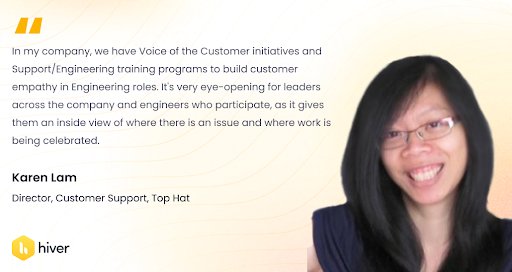
VoC programs also play a crucial role in reducing customer churn.
Dave Seaton, CEO & Principal Consultant at Seaton CX, highlights the impact of Voice of the Customer (VoC) in addressing churn. He shares an experience with a B2B SaaS company whose once-popular high-touch service model began losing customers due to industry changes.
It was a smash hit in the early 2010s but gradually experienced accelerated churn. That’s when they started interviewing customers about their journey, goals, and values.

Insights from VoC programs also enable companies to tailor their communications, offers, and services to meet the unique needs and preferences of individual customers or segments.
Fullscript, a digital health platform, is quite committed to integrating customer feedback into product development. Siobhán James, Director of Client Operations at Fullscript, highlights how they started their Voice of the Customer initiative a year ago, and now they’re already scaling it up.
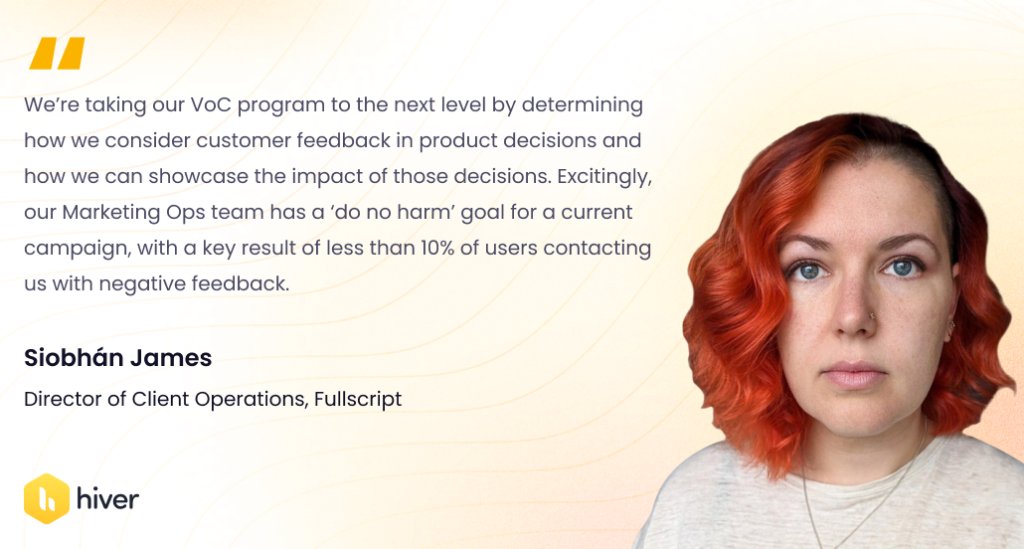
VoC (Voice of the Customer) programs are all about listening to what customers have to say about your products or services. This information is gold for your product’s growth. It’s these moments that can take your product from good to great.
Felisha (Lynskey) Wirtshafter, who leads the Customer Experience (CX) team at OpenSea, talks about how they listen to what their customers say and use that information to make their products better.
They have a special VoC report they look at every month that helps them understand what problems users are facing and what new features they might want. Felisha and her team work closely with the engineers to fix bugs and improve the product based on this feedback.
Felisha also mentions that it’s not easy to influence product development or fixes, across the board. Your company needs a culture where every team member, not just CX, grasps the customer’s perspective.

Recommended Reads:
– How Customer Support Influences Product Excellence
– Why Customer Support Needs a Seat at the Table
Also, maintain regular communication between product and support teams.
To make sure products keep getting better in a way that customers really notice, it’s important for the employees making the product and the employees talking to customers to chat regularly.
When these teams connect, they can help each other see the big picture and the little details about what customers love and what they don’t.
This is rightly pointed out by Vinay Damani, Product Support Manager at SourceBreaker. According to him, support and product teams need to work together and it needs to be both ways. This ensures that customers feel heard and that change gets implemented.
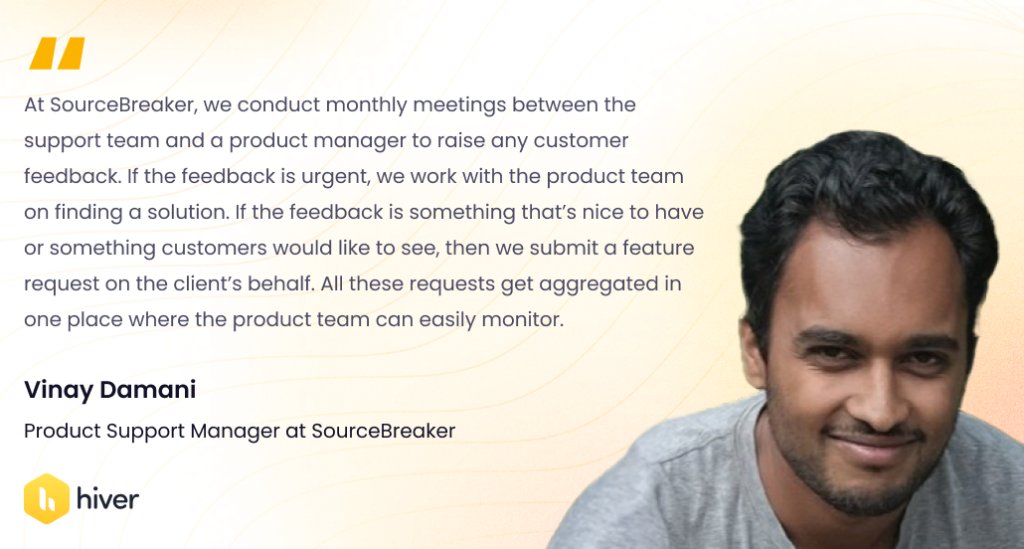
It’s wonderful how this strategy has helped SourceBreaker to:
- Reduce the number of negative CSATs by 5% from customers.
- Increase retention and trust with large enterprise accounts by working through issues and product changes.
- Reduce the instances where customers are waiting for fixes for long-term issues by 20%.
- Communicate better with customers about what is possible and provide workarounds when not possible.
Quick communication between product and support teams shows that the company doesn’t just collect feedback but acts on it. This reinforces a culture that values customer input at every level.
In some companies, there’s a strong collaboration between these teams, or occasionally, they are overseen by the same leader.
For instance, at livepro.com, a specialized knowledge management system for contact centers, the Head of CX is also the Head of Product.
Kristin Sprows, Solutions Consultant at livepro, suggests how this benefits their Voice of the Customer initiative.
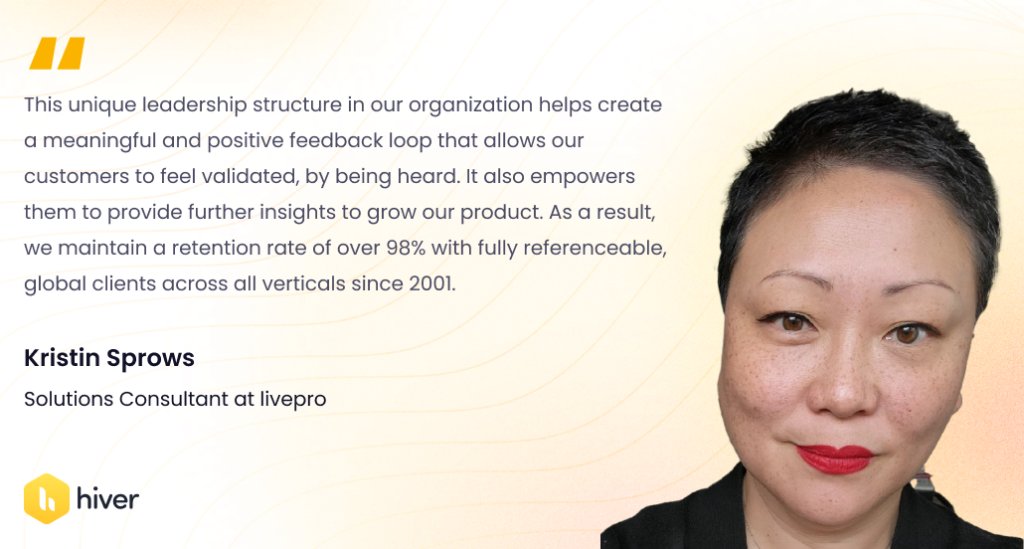
Final Words
My discussions with business leaders who predominantly work in customer support show how different companies use feedback from support teams to improve their products.
At Hiver, for instance, our customer service team typically handles about 80-100 different customer feedback instances every month – dominated by suggestions for new features.
We have specialized channels on Slack, one of them being a ‘feature-requests’ channel, where the support team classifies each feedback as either ‘Urgent,’ ‘Important,’ or ‘Nice to Have.’
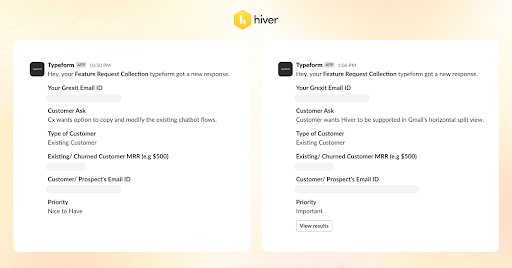
Also, there are monthly sessions where our product and customer success teams come together to meticulously review this feedback.
The stories from customer service leaders show us a simple yet powerful idea: listening to what customers say can make products better. Companies that really pay attention to customer feedback, especially through Voice of the Customer (VoC) programs, end up making products that people love more.
Also, it’s very important for the people who make the product and the people who talk to customers to work closely together. When these teams share what they know and learn from each other, they can make smarter decisions that make products better in ways that align with customer needs and expectations.

































